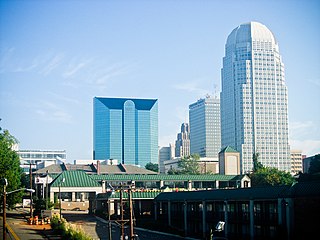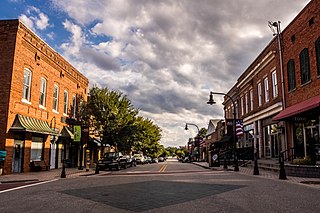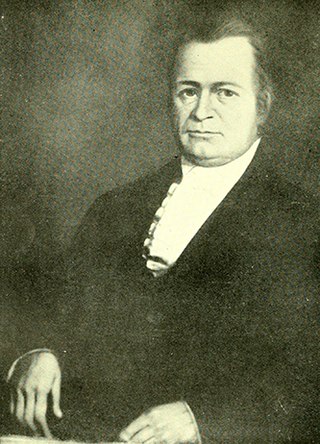
Winston-Salem is a city in and the county seat of Forsyth County, North Carolina, United States. In the 2020 census, the population was 249,545, making it the second-largest municipality in the Piedmont Triad region, the fifth-most populous city in North Carolina, and the 90th-most populous city in the United States. Winston-Salem is home to the tallest office building in the region, 100 North Main Street, formerly known as the Wachovia Building and now known locally as the Wells Fargo Center.

Fuquay-Varina is a town in southern Wake County, North Carolina, United States, lying south of Holly Springs and southwest of Garner, and north of the Harnett County town of Angier and west of the unincorporated community of Willow Springs. The population was 17,937 at the 2010 census, and estimated at 36,736 as of July 2021. The hyphenated name attests to the town's history as two separate towns. Fuquay Springs and Varina merged in 1963 to create the modern town. Economically, the town initially grew due to tobacco trade and agriculture, but has seen recent population growth and real estate development due to its proximity to Research Triangle Park.

Wake Forest is a town in Franklin, Granville and Wake counties in the U.S. state of North Carolina; located almost entirely in Wake County, it lies just north of the state capital, Raleigh. At the 2020 census, the population was 47,601. That is up from 30,117 in 2010, up from 12,588 in 2000. The U.S. Census Bureau estimates the city's population to be 47,601 as of April 1, 2020. In 2007, the town was listed by Forbes magazine as the 20th fastest growing suburb in America, with a 73.2 percent increase in population between 2000 and 2006. Wake Forest was the original home of Wake Forest University for 122 years before it moved to Winston-Salem in 1956.

Cary is a town in Wake, Chatham, and Durham counties in the U.S. state of North Carolina and is part of the Raleigh-Cary, NC Metropolitan Statistical Area. According to the 2020 census, its population was 174,721, making it the seventh-most populous municipality in North Carolina, and the 148th-most populous in the United States. In 2022, the town's population had increased to 180,388.

Wake Forest University (WFU) is a private research university in Winston-Salem, North Carolina, United States. Founded in 1834, the university received its name from its original location in Wake Forest, north of Raleigh, North Carolina. The Reynolda Campus, the university's main campus, has been located north of downtown Winston-Salem since the university moved there in 1956. The Atrium Health Wake Forest Baptist medical campus has two locations, the older one located near the Ardmore neighborhood in central Winston-Salem, and the newer campus at Wake Forest Innovation Quarter downtown. The university also occupies laboratory space at Biotech Plaza at Innovation Quarter, and at the Center for Nanotechnology and Molecular Materials. The university's Graduate School of Management maintains a presence on the main campus in Winston-Salem and in Charlotte, North Carolina.
Auburn is an unincorporated community in Wake County, North Carolina, United States, just southeast of Raleigh. It lies approximately halfway between Garner and Clayton along Garner Road, a former alignment of US 70. The borders of the community are not well defined, but it is centered along Garner Road between Auburn Church Road and Guy Road.

The North Carolina State Capitol is the former seat of the legislature of the U.S. state of North Carolina which housed all of the state's government until 1888. The Supreme Court and State Library moved into a separate building in 1888, and the General Assembly moved into the State Legislative Building in 1963. Today, the governor and his immediate staff occupy offices on the first floor of the Capitol.

Calvin Jones was a North Carolina physician and was among the group of founders of the North Carolina Medical Society. He served from 1802 to 1832 as a trustee of the University of North Carolina. Jones was also elected to the North Carolina House of Commons and as the Mayor of Raleigh, North Carolina (1807–1809). In 1817 and 1819 he was Grand Master of Masons in North Carolina.

North Carolina Highway 98 (NC 98) is a primary state highway in the U.S. state of North Carolina and a semi-urban traffic artery connecting Durham, Wake Forest, and Bunn as well as many small to medium-sized towns in the north portion of The Triangle region of North Carolina. Running from downtown Durham, the route leaves the city to the east, running into a rural area near Falls Lake. As the road approaches Wake Forest, it widens to a four-lane divided highway and runs along the southern side of the city. Once leaving Wake Forest NC 98 becomes a two lane road again, running through rural areas east of Bunn. After a short concurrency with NC 39, NC 98 continues southeast to reach its eastern terminus at US 64 Alternate and NC 231 west of Spring Hope.

The Old North Carolina Mutual Life Insurance Company Building, also known as the Mechanics and Farmers Bank Building, is an office building at 114-116 West Parrish Street in downtown Durham, North Carolina. It formerly served as the headquarters for the North Carolina Mutual Life Insurance Company, which was formerly one of the nation's largest companies founded and owned by African-Americans. The building was declared a National Historic Landmark in 1975.

Falls, is an unincorporated community in Wake County, North Carolina, United States, situated on Old Falls of Neuse Road, between Raleigh and Wake Forest, near the Wakefield Plantation development. Falls Dam, on the Neuse River, is within the community.
The Harmony Plantation, also known as Montague-Jones Farm, is a historic plantation house located at 5104 Riley Hill Road near Wendell, North Carolina, a town in eastern Wake County. It was built in 1833, and is a two-story, three bay, single-pile, Greek Revival style frame dwelling. It is sheathed in weatherboard, has a hipped roof, and a gabled rear ell. The front facade features a centered, double-tier pedimented, front-gabled portico with bracketed cornice and unfluted Doric order columns. Also on the property is a contributing one-story, rectangular, beaded weatherboard building that once housed a doctor's office (1833).
The College at Southeastern is a Baptist Christian college located in Wake Forest, North Carolina, United States. It is affiliated with the Southeastern Baptist Theological Seminary.

The Crabtree Jones House, also known historically as the Nathaniel Jones Jr. House, is a residence at 3108 Hillmer Drive in Raleigh, North Carolina. Constructed around 1808-1811 by Nathaniel Jones, it is one of the few remaining large scale plantation homes in Wake County, and one of the oldest private residences in Raleigh. The home has received several additions since its initial construction, but is mainly known for its Federal-style front. Owned by the Jones family for more than 150 years, the house has fallen into disrepair in more recent decades. Following the purchase of the land the house sat upon by developers in 2012, Preservation North Carolina acquired the house and had it moved to a nearby residential neighborhood, where it sits today. The Crabtree Jones house was greatly influenced by the historical events it stood through while in turn influencing the way the Raleigh community developed around it, through both its people and through its land.

The Andrews-Duncan House is a historic building located at 407 North Blount Street in Raleigh, North Carolina, United States. Built in 1874 for a prominent businessman, the Italianate style home was designed by architect George S. H. Appleget. The house was added to the National Register of Historic Places (NRHP) in 1972 and is currently owned by the state government. A large tree named after a presidential candidate once stood behind the house and is commemorated with a historical marker.
Calvin Wray Lawrence House is a historic home located near Apex, Wake County, North Carolina. The house was built about 1890, and is a two-story, three-bay, single-pile frame I-house with a central hall plan. It has a triple-A-roof; full-width, hip-roof front porch; and a two-story addition and two-story gabled rear ell. Also on the property are the contributing well house, outhouse, and storage barn.

Nancy Jones House is a historic home located near Cary, Wake County, North Carolina. It was listed on the National Register of Historic Places in 1984. It is the oldest surviving structure in Cary.
Thompson House, also known as the William Thompson House, is a historic plantation house located near Wake Forest, Wake County, North Carolina. It was built about 1853, and is a two-story, three-bay Greek Revival-style frame dwelling. It is sheathed in weatherboard, sits on a fieldstone foundation, and has four brick chimneys, two on each side. Also on the property is a contributing 1+1⁄2-story barn. The house and barn were moved to its present location in 2004.
Wake Forest Historic District is a national historic district located at Wake Forest, Wake County, North Carolina. The district encompasses 245 contributing buildings, one contributing site, and five contributing structures built between about 1890 and 1953 and located in the historic core of the town of Wake Forest. It includes notable examples of Greek Revival and Federal style architecture. Located in the district are the separately listed Lea Laboratory, South Brick House, and the Powell-White House, a contributing resource in the Glen Royall Mill Village Historic District. Other notable buildings include the historic campus of Wake Forest College, Wake Forest Baptist Church (1913), Magnolia Hill (1928), Calvin Jones House, John M. Brewer House, Wait-Taylor House (1843), Taylor-Purefoy-Poteat-Swett House, Community House, St. Catherine of Siena Catholic Church, the Powers Store (1897), and former Water and Light Building (1909).
Purefoy–Dunn Plantation is a historic plantation and national historic district located near Wake Forest, Wake County, North Carolina. The Greek Revival style plantation house was built about 1814 and remodeled about 1850. It is a two-story, L-shaped, heavy timber frame building. It has a low hipped roof and is sheathed in clapboards. The front portico was removed in the 1960s or early 1970s. Also on the property is a contributing mid-19th century gable-roofed frame smokehouse.

















